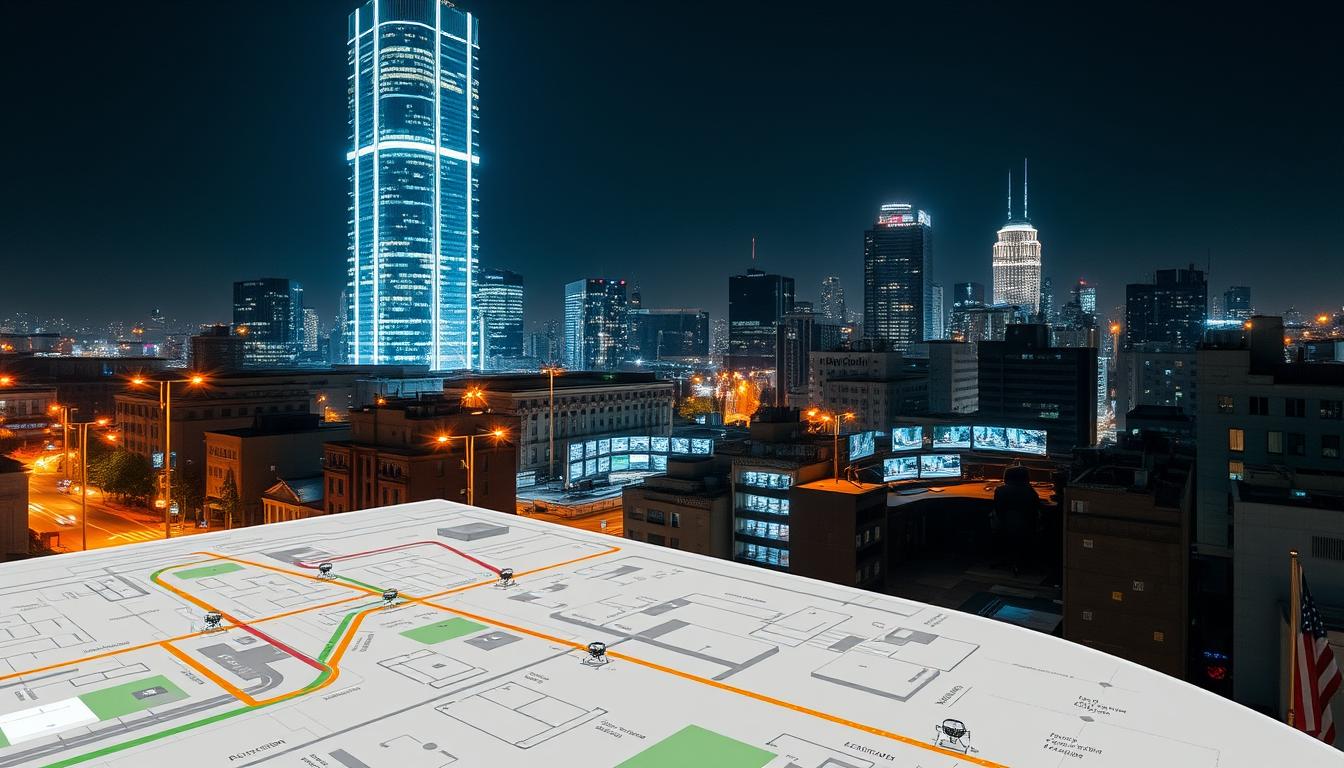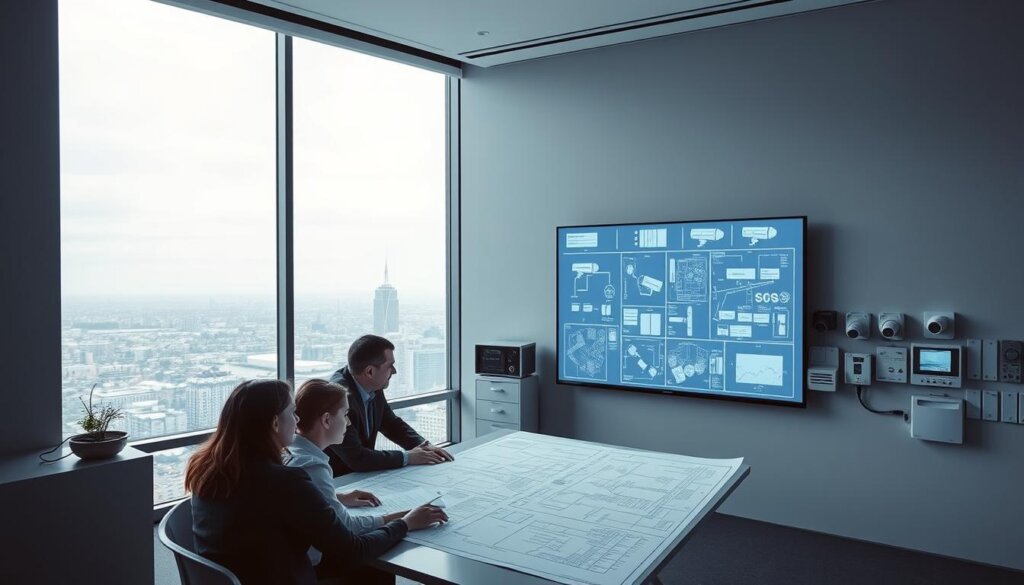One evening, I watched a rapid response team rush by a local mall. Their lights were flashing, ready to act fast. It made me think about how much planning goes into their routes.
They had to balance speed and safety. They chose the best routes to get there quickly. This showed me how important it is to have an efficient alarm system.
With the right planning, every second matters. It helps teams protect us better. This article will explore how to improve security system route planning. We’ll look at modern technology and smart practices to make responses faster and more effective.

Key Takeaways
- Security system route planning is essential for timely responses.
- Alarm system efficiency directly impacts overall security effectiveness.
- Innovative technologies enhance response optimization.
- Integrating strategic practices can safeguard properties more effectively.
- Balancing speed and operational efficiency is critical for security teams.
Understanding the Importance of Security System Route Planning
Effective security system route planning is key to quick responses to threats. It sets up specific paths for emergency responses. This way, I can cut down response times and use security resources wisely.
When I look into security planning, I see how important regular checks are. These help me update routes as needed. Using new tech also boosts safety and resource use. My goal is to stay ahead of threats, making our security efforts more effective.
Key Components of Effective Security System Route Planning
When I think about security route planning, a few key elements stand out. Threat assessment is a must to spot vulnerabilities early. This helps me focus on the most critical risks and plan a solid response strategy.
Knowing the area’s layout is also vital. It affects how well security operations run. Understanding the terrain helps me create the best routes for my team. This ensures they can react fast in any situation.
Using security tools like cameras and alarms is also important. They give me real-time updates on the security situation. This helps me make better decisions quickly.
Training my team is essential, too. A well-trained team can handle any situation with confidence. They can adjust quickly to new challenges, making our security efforts more effective.
Threat Assessment and Its Role in Route Planning
When I explore security system route planning, I see how vital a thorough threat assessment is. It’s key to understand risks to create effective strategies. This helps protect assets and people.
By focusing on threat identification, I can spot vulnerabilities that could be very harmful. For example, threats like burglary, vandalism, or environmental issues need to be recognized. This helps build a strong security plan.
Identifying Possible Threats
Identifying threats means looking at them from different angles. I consider both human dangers and natural disasters. A detailed assessment helps me sort threats by how likely they are and their impact.
This approach guides me in setting up the right safety measures. It’s a clear way to protect against various threats.
Assessing Risk Levels
Risk assessment in security is always changing. After finding different threats, I figure out their risk levels. This tells me which ones need urgent action and which can wait.
This helps me create a strong defense strategy. It lets me use resources wisely, focusing on the most important areas.
Optimizing Response Times with Smart Route Planning
In the field of security, optimizing response times is key. Smart route planning uses advanced data and dynamic routes to get personnel to critical spots fast. It also helps by using real-time traffic updates to avoid delays.
Using new tech like aerial drones helps us watch areas better. This smart way cuts down time and boosts our team’s efficiency. With smart planning and quick response, my team is always ready to act fast.
Best Practices for Security System Route Optimization
Adopting best practices in security route optimization boosts efficiency. Advanced routing software is key. It helps visualize routes and spot trouble spots. With the right software, we can plan paths that adjust for traffic, weather, and threats.
Utilizing Advanced Routing Software
Advanced routing software brings big benefits. It quickly finds new routes to cut down on delays. This is critical in urgent situations. By using this software, we improve safety and efficiency.
Leveraging Geographic Information Systems (GIS)
Geographic Information Systems (GIS) are essential in security planning. They create detailed maps of facilities and security assets. GIS helps identify risk areas and optimize routes. This leads to a stronger security posture and better resource management.
The Role of Technology in Security System Route Mapping
Technology has changed how we plan for safety. It makes security planning and action more coordinated. This is key for quick and effective responses in emergencies.
Integration with Monitoring Systems
Monitoring systems are very important. They keep security teams informed in real-time. This helps them react faster and more accurately to threats.
Utilizing Mobile Applications for Enhanced Coordination
Mobile apps have also made a big difference. They help teams stay connected and share information quickly. This improves how well they can handle emergencies together.

Considerations for Physical Barriers in Route Planning
In my experience with security route planning, choosing the right physical barriers is key. Fences, gates, and walls set the security perimeter. They must be durable and withstand weather, and easy for security teams to move around.
The way these barriers are placed is also very important. Proper placement helps control who can enter and who can’t. By planning carefully, we can make sure security is effective without making it hard for staff to get around.
Training and Personnel Management for Effective Response
Good response to security issues depends on more than just systems. It also needs well-trained people. Training security staff well helps them plan routes and make quick decisions during emergencies. This shows a proactive approach to managing security.
Many places are now looking at new ways to handle security. They use remote monitoring systems. This lets a team watch many places at once, making responses faster without needing staff everywhere. This way, they keep security high while saving costs.
Alternatives for On-Site Security Staff
New tech offers great alternatives to having staff on site. Automated alerts and AI can watch for problems and act fast. These tools work with trained staff to make a strong, efficient security setup.
Cost-Efficiency in Security System Route Planning
Understanding cost-efficient security planning is key to making the most of security investments. A smart approach to budgeting for security systems boosts safety and saves money in the long run. By choosing automated solutions and optimizing routes, I cut down on costs related to people.
Value-based security investments are vital. I look for solutions that offer the best value, not just the cheapest upfront price. This means investing in tech and systems that save money over time. A well-planned strategy helps avoid overspending and ensures a good return on investment.

Long-term planning helps predict expenses, making budgeting easier. By analyzing needs, I know where to invest and where to save. This balanced approach leads to more effective and sustainable security solutions.
Security System Route Planning in Large Facilities
Planning security systems in big places like malls or corporate buildings is tough. It’s because these areas are huge and complex. To keep everyone safe, it’s key to plan security routes well.
Using layered security helps a lot. It means setting up different levels of protection. This way, security teams can manage resources better and respond faster to threats.
Layered Security Approaches
Layered security uses many strategies for big places. It includes zoning, making clear paths, and assigning specific tasks. Zoning helps sort areas by risk, guiding security teams.
Clear paths let emergency teams move fast. And having the right resources in the right places helps watch over important areas.
By using these layered security steps, managers can make their big venues safer. This, along with good route planning, helps cut down response times in emergencies.
Conclusion
Looking back at this article, it’s clear that planning security routes is key to safety and quick responses. We’ve seen how tech, people, and clear rules work together for strong security. Each part, from using smart software to training staff, is essential for keeping our systems safe.
As we wrap up, one thing stands out: we must always be ready to change. Security threats are always new, so our plans and tools need to keep up. Using smart security tactics helps us face today’s dangers and get ready for tomorrow’s.
In the end, having a good plan for security routes helps us stay ahead. This article shows why we need a flexible security plan that keeps getting better. This way, we can stay safe and work better.
See how FieldAx can transform your Field Operations.
Try it today! Book Demo
You are one click away from your customized FieldAx Demo!
FAQ
Why is route planning so important for security systems?
Route planning is key for security systems. It affects how fast and well security teams can handle threats. By setting up specific routes, they can respond quicker and use resources better.
How can I optimize security system routes?
To improve security routes, use smart tech and data analysis. Tools like real-time traffic info and advanced software cut down response times. This makes operations more efficient.
What role does threat assessment play in route planning?
Threat assessment is essential in planning routes. It helps identify and rank threats. This way, resources are used wisely and a strong defense is built.
What tools can aid in securing routes for security systems?
Advanced software and GIS are top choices for securing routes. They help map routes, spot trouble spots, and plan efficient paths with current data.
How does technology integrate into security system route mapping?
Tech is vital in mapping routes for security systems. It gives real-time updates and helps teams communicate. This makes handling security incidents smoother.
Why should physical barriers be considered in route planning?
Physical barriers like fences are key in setting up a secure area. They need to be strong, easy to get to, and placed right. This helps security teams overcome obstacles effectively.
What training is necessary for effective security responses?
Good training is needed for security teams to respond well. It should cover route planning and response strategies. Also, using remote monitoring and automated alerts can boost security.
How can I maintain cost efficiency in security system investment?
To keep costs down, invest wisely in tools and tech. This can save money in the long run by cutting down on staff costs. Smart budgeting also helps get more value for money.
What unique challenges exist in route planning for large facilities?
Planning routes for big places like malls is tough. They need layered security and detailed plans. This ensures quick responses and keeps everyone safe.
Author Bio
Co-Founder & CMO at Merfantz Technologies Pvt Ltd | Marketing Manager for FieldAx Field Service Software | Salesforce All-Star Ranger and Community Contributor | Salesforce Content Creation for Knowledge Sharing






